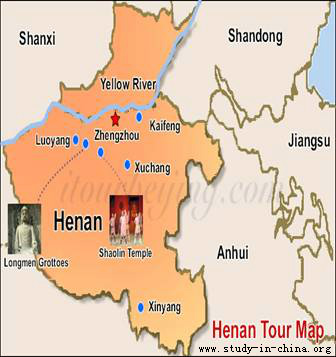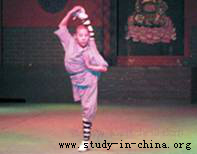| Home > China Feature |
Chinese Kung fu Temples'Destination
Location and Introduction:

Shaolin Kung fu is the most famous of the martial arts heritages with over 1,500 years of history. It was developed from the Shaolin Temple, in the region of Song Mountain, Henan Province. While cultivating in the thick forest of the high mountains, monks created a set of body-building exercises by learning the postures of flying, jumping and running from birds, beasts and fish. Gradually, these body-building exercises developed into a sort of boxing through long practice and improvement, which is generally called ‘Shaolin boxing’. Now, the Shaolin Temple has become the most popular travel destination in Henan Province, especially for the Chinese Kungfu-lovers.
.jpg)
Shaolin Temple:
.jpg)
The Shaolin Temple was founded in 496 AD during the Northern Wei Dynasty to honor an Indian monk named Bodhidharma. It is located in the region of Song Mountain, Dengfeng city. The birth- place of Chinese Buddhism is said to have begun here and is also the home to China's famous marital arts. When travelling the temple, one site that must be visited is the Pagoda Forest. There are 243 stupas located inside the temple, all with different architectural styles. The first stupa built here was in 791 AD and the last one can be dated back to 1803 AD. Altogether, there were 6 dynasties that took place during the construction of these stupas.
.jpg)
Shaolin Temple embraces many excitiing attractions, such as The Hall of Heavenly Kings, the Mahavira Hall, the Pagoda Forest, the Dharma Cave and the Shaolin Temple Martial Arts Center, etc. Travelers can follow the virtual guide about the Shaolin Temple. The First gate of Shaolin Temple is called Shanmen Hall. The hall enshrines the Maitreya Buddha. Two sides of the corridor behind the hall's gate are paved with inscriptions on stone steles made during several different dynasties, and lastly, the Hall of Heavenly Kings.
There are two figures depicting Vajra (Buddhist warrior attendants) standing on both sides. Inside the hall has figures of the Four Heavenly Kings who are responsible for inspecting peoples' behavior, helping the troubled, and blessing the people. Then you will arrive at the Mahavira Hall. The complex's center is right before your eyes. Both important celebrations and regular prayers are held here. 18 Buddhist Arhats stand along the eastern and the southern walls of the hall. The Pagoda Forest in Shaolin Temple is the largest of China's pagoda complexes in Shaolin Temple.
Inside Shaolin itself, Fangzhang Hall is the resting place for abbots. In 1750, Qing Emperor Qianlong lived in this hall during his visit to the temple. Afterwards, the temple was known as Long Ting, or Hall of the Dragon (due to the belief that the emperor is the son of the dragon). When entering the temple, one will first see a hall with double eaves with a Bell Tower and Drum Tower located nearby. Daxiongbaodian is the main hall of the temple, which was originally built in the Jin Dynasty but was destroyed in 1928.
In the middle of the hall, the Trinity Buddha is enshrined. Outside, you will see the two monasteries that were named: the Ancestor's Monastery and the Second Ancestor's Monastery. The first monastery was built by a Dharma's disciple to commemorate Dharma's nine years of meditation in a cave. The second monastery is a nursing home of the second ancestor Huike who cut his left arm in order to show his sincerity to the study of Buddhism from Dharma. The cave you see is the Dharma Cave. The cave is seven meters deep and three meters high. Many stone inscriptions are carved on both its sides.
In a word, Shaolin Temple is a good travel spot for visitors. You will have a better understanding of Chinese Buddhism and the martial arts in Shaolin Temple.
Information guide on "how to travel to Shaolin Temple":
Address: Dengfeng, Henan
Admission Fee: 110 yuan
Opening hours: 8:10 am-5:30 pm
Kungfu Performance:

When referring to Bruce Lee, Jackie Chan or Jet Li, you will instantly associate them with Chinese Kung Fu. That's right; anyone who has watched Chinese Kung Fu movies or TV shows played by them will be deeply impressed by the performances. Kung Fu is one of the most well know examples of traditional Chinese culture with a history of thousands years. It is probably one of the longest-lasting traditional Chinese physical activities which utilize both brawn and brain. Chinese Kung Fu has become a international sport for the people around the world who want to learn and use to attain its inherent benefits. Chinese Kung Fu performances have become an important learning course for most foreigners when they travel in China.
The movements of Kung Fu include: kick, boxing, wresting and seizing, which are performed by rules; Sects of Kung Fu are various. As the old Chinese saying goes," In the north, Shaolin Kungfu is primarily recommended. While in the south, Wudang Kungfu is especially valued." Both of them lay emphasis on the external practice for Jing (genuine energy), Qi (vital energy) and Shen (spirit) and internal practice for muscle, bone and skin.
These early dances were recorded to be imitations of animals. The early relationship between fighting and dance moves can be seen in the marital dance called "The Dance with Shield and Axe". Wrestling was also practiced between soldiers in Butting with Horns. By the end of this period, unarmed combat was an advanced skill with several methods of attack, defense, feints and counter-attack. Fencing was also common.
The Shaolin monks studied Chinese Kung Fu, which was defined at that time as any of the various Chinese martial arts. The Shaolin Kung Fu is particularly known for the different moves named after animals: Dragon, Tiger, Crane, etc. Kung Fu, meaning ability, was originally used by the West by a Jesuit Missionary named Pere Amoit. However, today, Wushu is the terminology that is better used to describe Chinese martial arts.
Below are tips for Kung fu performances:
Hong Ju Chang
Address: No. 44, Xinfu Street, Worker's cultural Palace, Chongwen district
Opening hours: 7:30 pm-8:15 pm
Art
 more
moreChina Beijing International Diet ...
Recently, The hit CCTV documentary, A Bite of China, shown at 10:40 ...

Exhibition of Ancient Chinese Jad...
At least 8,000 years ago, Chinese ancestors discovered a beautiful...

Longmen Grottoes
The Longmen Grottoes, located near Luoyang, Henan Province, are a tr...

Custom
 more
moreWeb Dictionary
Martial Arts
Tai Chi Master Class Held in Moscow
MOSCOW, June 15, 2016 (Xinhua) -- Students learn from Shaolin ...
Celebriting 70 years' efforts in restoring Mogao...
Work is being carried out at the restoration site of cave No 98 a...
Hong Kong Children's Symphony performs in Seattle
Under the theme of Tribute to the Golden Age, a concert featuring a ...





 print
print  email
email  Favorite
Favorite  Transtlate
Transtlate 








